
Steamboat Engravings - Page 1
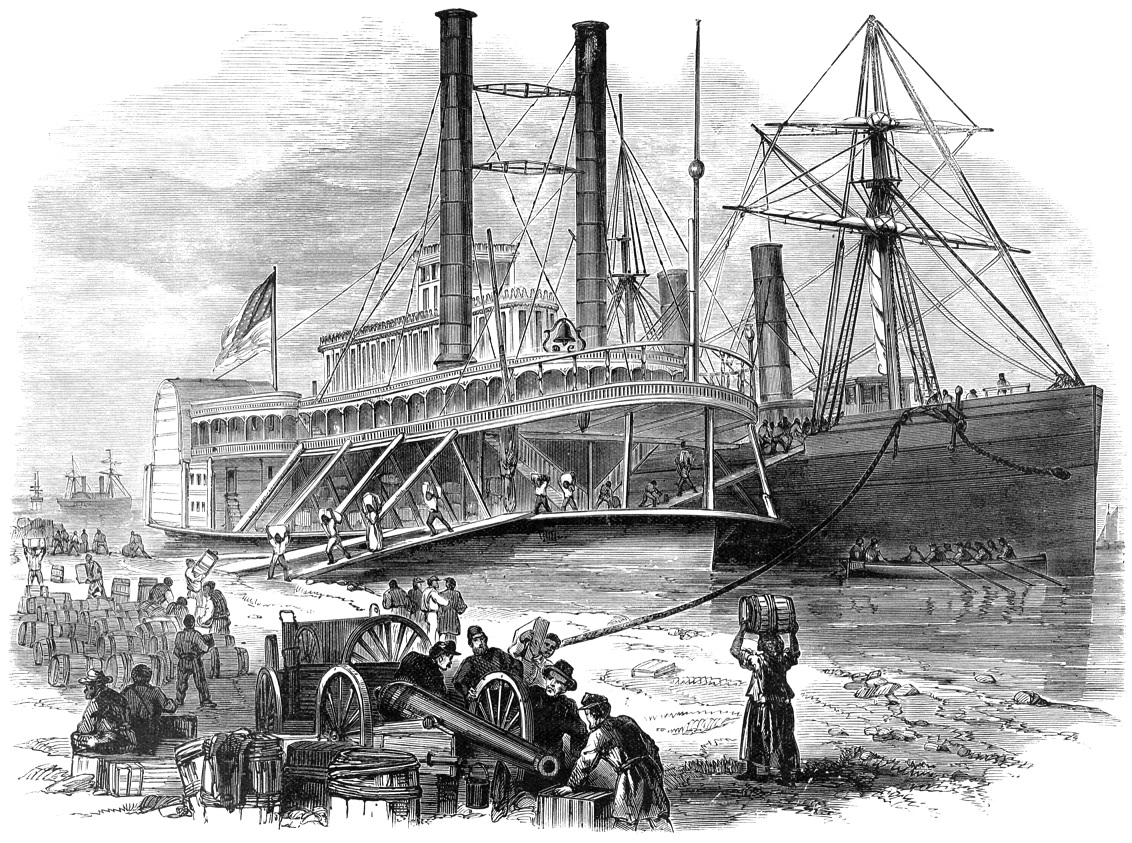
Excerpted from the following book:
"The soldier in our Civil War : a pictorial history of the conflict, 1861-1865 illustrating the valor of the soldier as displayed on the battle-field from sketches drawn by Forbes, Waud, Taylor, Beard, Becker, Lovie, Schell, Crane and numerous other eye-witnesses to the strife."
by Frank Leslie and Paul Fleury Mottelay
edited by Thomas Campbell-Copeland, Robert Burns Beath and Paul Vandervoort
Published 1893
Caption:
"THE BANKS EXPEDITION—SCENE ON THE LEVEE, BATON ROUGE, LOUISIANA CONTRABANDS UNLOADING MILITARY STORES FROM THE UNITED STATES TRANSPORT NORTH STAR, OVER THE MISSISSIPPI STEAMER IBERVILLE.
The IBERVILLE had quite a history in connection with the military operations on the Mississippi. She was taken possession of by the United States authorities on the surrender of New Orleans, and was engaged as a transport during the expedition. She several times ran the gantlet of Confederate batteries and guerrillas. On one occasion she sustained a running fire from a battery of six guns for at least twenty minutes, while passing Donaldsonville, having four men killed and four wounded, one of her engines disabled and her upper works riddled."
Way's Packet Directory Number 2700
IBERVILLE
Sidewheel packet boat
Built at New Albany, Indiana in 1859. 368 tons. 179 x 35 x 6.3. Engines, 22's- 7 ft. Four boilers.Built for the Bayou Sara Mail Co. of New Orleans, Eugene Lanone, president.
The IBERVILLE was used by the Confederates in war service, captured by the U.S. and they used her as a transport. Burned at New Orleans, laid up, July 13, 1866. Rebuilt 1867. Owned and operated by Capt. A. T Dunbar, New Orleans. Sold March 1867 to J. Morgan Hall, New Orleans with Capt. Emile F Gross, master Sold March 1869 to Capt. Samuel J Seymour, New Orleans. Ran New Orleans-Bayou Sara in her latter days. Off the lists by 1869.
Transcript of orders given by General Franklin during the Civil War with history that pertain to what was taking place in the engraving:
SPECIAL ORDERS,
Headquarters 19th ARMY CORPS
No. 12.
New Orleans
September 2, 1863.
I.
The First Brigade, First Division, with the light batteries already designated, will embark immediately on the transports now lying at Baton Rouge, as follows:
Steamer GENERAL BANKS, One hundred and sixty-first New York Volunteers, and horses of officers entitled to draw forage steamboat ARAGO, Thirtieth Massachusetts and Second Louisiana Volunteers
steamboat IBERVILLE, One hundred and sixteenth New York and One hundred and seventy-fourth New York Volunteers.
At New Orleans, the troops on board the ARAGO and IBERVILLE will be transferred to the transport ALEXANDER
Steamer POCAHONTAS, Third Division, First Brigade, One hundred and sixty-fifth New York Volunteers, and Battery F, First Artillery;
steamer NORTH AMERICA, Fourteenth Maine, One hundred and sixty-second New York, and One hundred and tenth New York.
Horses of officers entitled to draw forage, on steamer BELVIDERE; second Brigade
steamer CRESCENT, Twenty-sixth Massachusetts Volunteers and First Texas Cavalry
steamer CONTINENTAL, Eighth New Hampshire, One hundred and thirty-third New York, and One hundred and seventy- third New York.
Horses of officers entitled to draw forage, on hoard BELVIDERE;
steamer EXACT, First Vermont Battery.
II.
The troops will carry three days' cooked rations in their haversacks.
Ten days' additional rations will be embarked on each boat, of which three days' rations must be easily accessible.
By order of Major-General Franklin:
WICKHAM HOFFMAN, Assistant Adjutant-General.
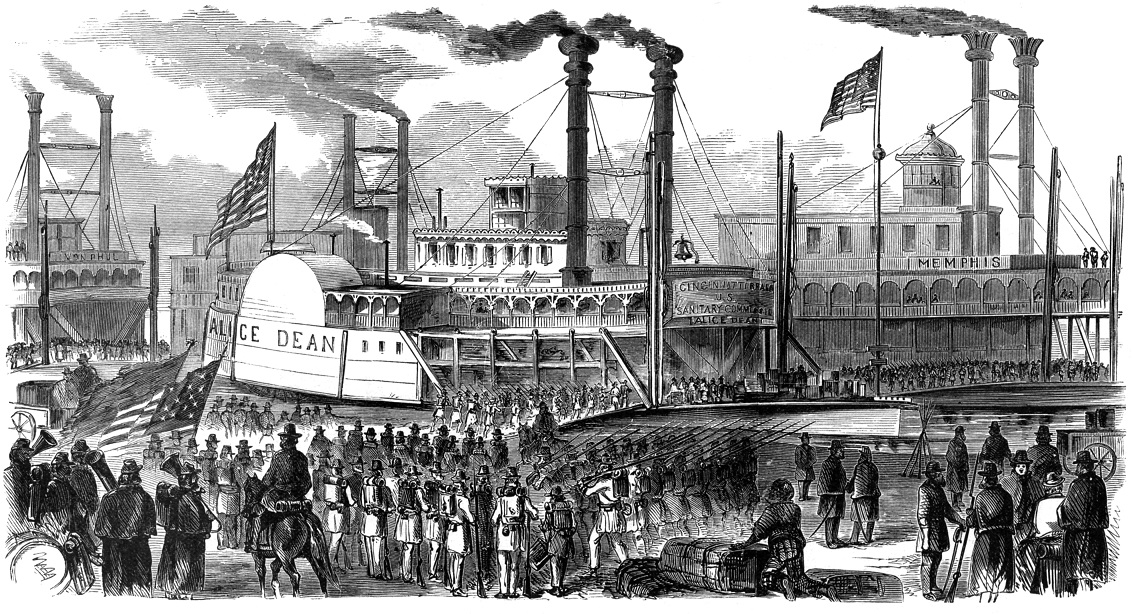
From the book entitled:
"The soldier in our Civil War : a pictorial history of the conflict, 1861-1865 illustrating the valor of the soldier as displayed on the battle-field from sketches drawn by Forbes, Waud, Taylor, Beard, Becker, Lovie, Schell, Crane and numerous other eye-witnesses to the strife."
by Frank Leslie and Paul Fleury Mottelay edited by Thomas Campbell-Copeland, Robert Burns Beath and Paul Vandervoort
Published 1893
The caption for the ALICE DEAN engraving:
"REINFORCEMENTS FOR GRANT'S ARMY LEAVING MEMPHIS, TENNESSEE
Our sketch shows the ALICE DEAN, a crack Western steamer, leaving Memphis with re-enforcements, and with doctors, nurses, etc., for the wounded. She was in charge of the Cincinnati branch of the United States Sanitary Commission, and commanded by Mr. R. B. Moore, of Cincinnati. She was a very fast boat, having run up to Cincinnati from Memphis in 2 days, 23 hours and 5 minutes. The scene depicted was one of constant occurrence, as troops were pouring daily into Memphis from all parts."
ALICE DEAN
Way's Packet Directory Number 0155
Sidewheel packet boat
Built at Cincinnati, Oh. in 1863. 411 tons. Ran Cincinnati-Memphis.
When Gen. John Hunt Morgan and his cavalry, often referred to as Morgan's Raiders, crossed the Ohio River from Kentucky into Indiana on July 8, 1863, they appropriated a small packet named JOHN T McCOMBS and used her as a decoy to hail down and capture the ALICE DEAN. They used the DEAN as a ferry, and afterwards burned her. Her machinery was salvaged in the fall of 1863 and auctioned off to the C.T Dumont Co. for $4,500. The Morgan crossing was at Brandenburg, Ky., and the DEAN was burned along the Indiana shore between Morvin's Landing and Mauckport.
Abridged article regarding plays to raise the remains of the ALICE DEAN where she sank in the Ohio River;
3/12/2015 6:57:00 PM
Plan revealed to recover sunken Civil War-era steamboat near Mauckport
indianaeconomicdigest.com
Ross Schulz, Corydon Democrat
Clarence Merk Jr., formerly of Laconia, continues to move forward with his plan to raise the Alice Dean, a Civil War-era steamboat from the Ohio River.
The boat was burned and sunk by Confederate Brig. Gen. John Hunt Morgan and his cavalry near Mauckport during the Civil War in June 1863.
Merk detailed the plan and updated the progress to the Mauckport Town Council on March 2.
He said the area where the ship was sunk—generally between Morvin's Landing and Buck Creek—will eventually be designated as a national park.
"We have national treasure," Merk said. "It's something people have never seen."
And Mauckport could see some benefit from the project, if it goes according to plan, he added.
Merk said the Navy, as well as the National Registry of Historic Places, now officially recognizes the Alice Dean as a military casualty of a battle on the Ohio River near Morvin's Landing involving Home Guard militia, The Heth Rifle Corps led by Col. John Timberlake under the command of Louis Jordan and two Union gunboats, the USS Springfield and the USS Elk.
"On July 7 and 8, 1863, a 24-hour battle ensued, including a five-hour cannon battle waged with Confederate forces, trying to prevent them from crossing into Indiana," Merk said. "The inability of combined Union land and naval forces to prevent an invasion allowed the infamous Morgan to commandeer two steamships, the civilian ship J.T. McCOMB, docked at Brandenburg, and a huge, new luxurious wooden hull side-wheeler packet ship named the ALICE DEAN that recently had been chartered to the Cincinnati Sanitary Commission by the U.S. Navy to transport medicines, supplies and wounded troops between Memphis, Tenn., and Cincinnati. The ALICE DEAN was never relieved of her duty and charter."
Last May, Merk led a combined effort to find the ship and see how much of it is still intact. With the help of Indiana conservation officers, the Louisville Rescue and Dive Team and the U.S. Coast Guard, Merk identified its location and sonar showed at least one large piece of the ship was still intact.
Merk said he's working on establishing a 20-year plan for the Alice Dean, which could include a museum on both sides of the Ohio River, once it's raised, as well as the chance for economic growth, such as a floating restaurant, a dock, marina, fuel station, riverside park or local craft station.
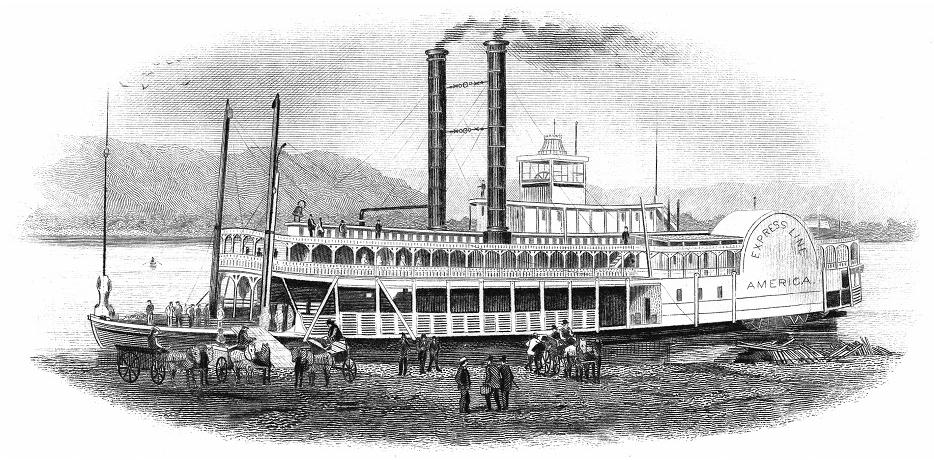
Old engraving, possibly intended for a packet company letterhead, an advertisement or illustration.
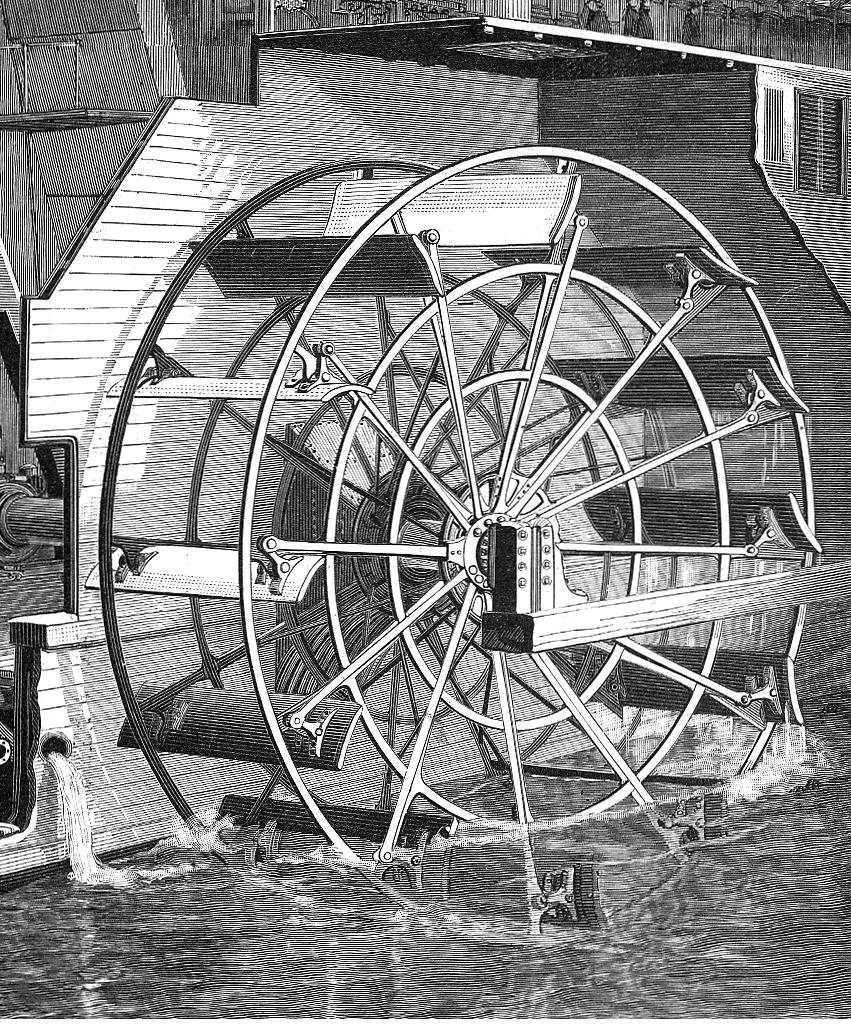
Detail from the cover of an 1896 issue of Scientific American showing a "cutaway" view of the S.S. Adirondack, an east coast walking beam style steamship. Wish it was of a Western Rivers boat but thought you'd enjoy seeing the precision draughtsmanship and excellent engraving representing the sidewheel.
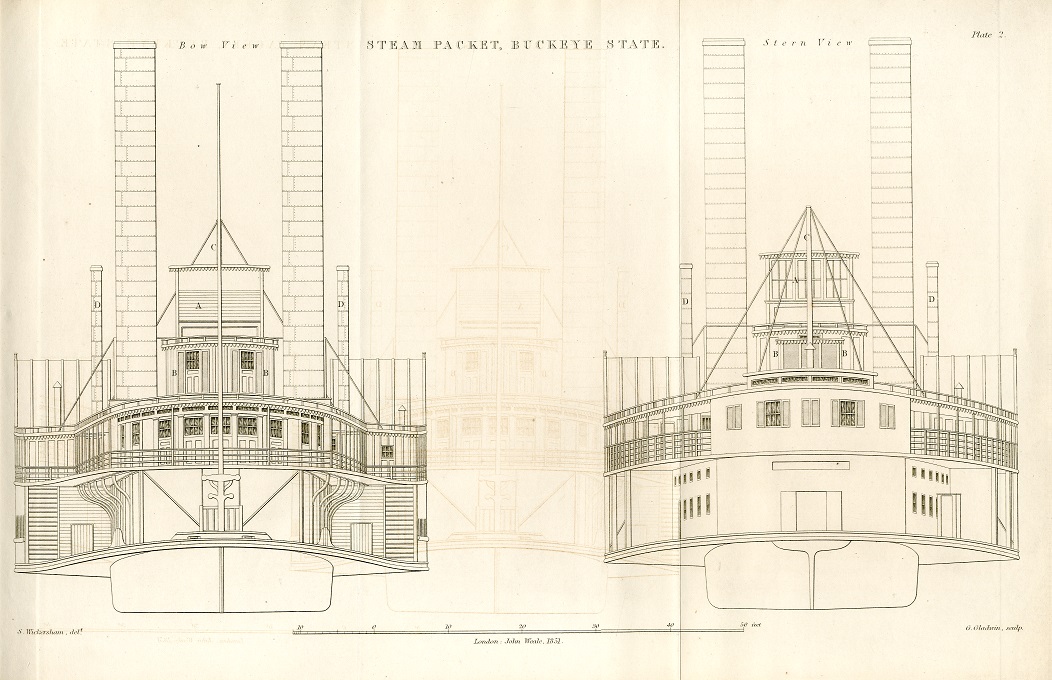
A scan of one of a set of four engravings from an 1851 publication that I was fortunate to locate through a dealer in Glasgow, Scotland.
The distance between the far left portion of the bow view and the far right portion of the stern view is 16 3/4 inches.
"Bow & Stern Views of Steam Packet, BUCKEYE STATE
S. Wickersham, delt. (del., delt., or delin. signified "drawn by". The name of the artist who who did the original drawing that the engraving reproduced). G. Gladwin, sculp. (sculp, or sculpt. signified "engraved by"). London : John Weale, 1851 (published by)"
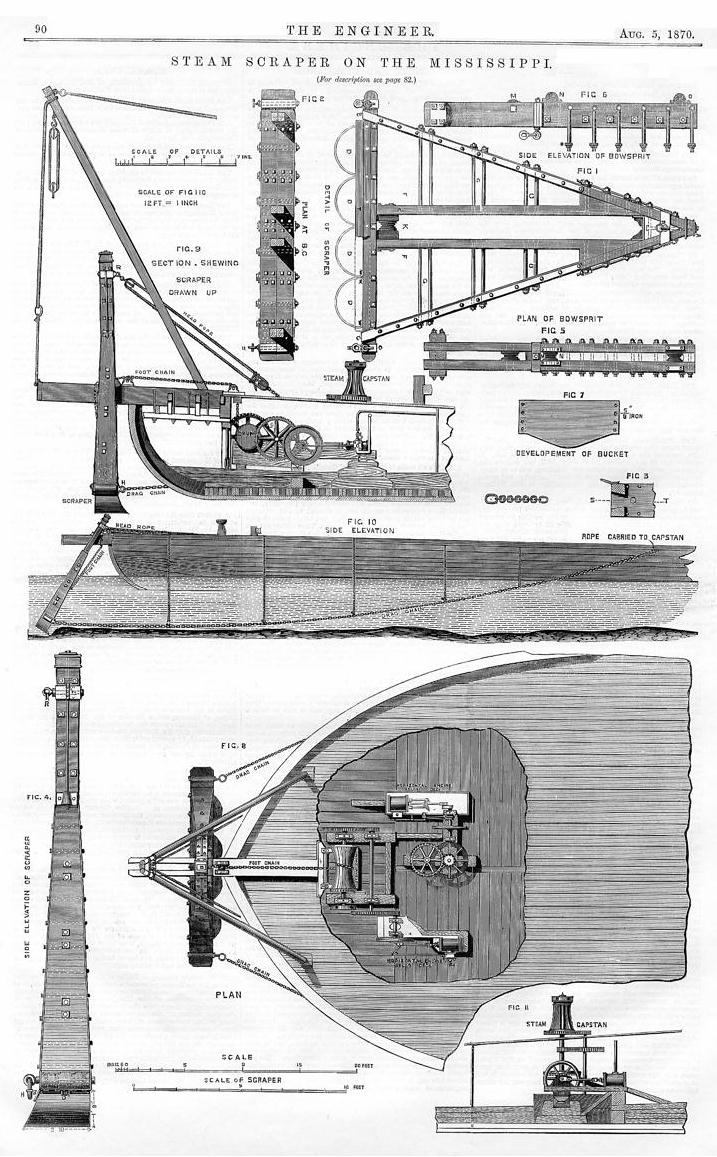
Attached Page 90 from ENGINEER Journal, August 5th, 1870 containing a detailed drawing of a STEAM SCRAPER ON THE MISSISSIPPI. On page 96 of the same issue was an engraving entitled DREDGING ON THE MISSISSIPPI, LONG'S APPARATUS.
Below are Jim Hale's comments on the drawing and the photograph:
THE STEAM SCRAPER MUST HAVE BEEN USED TO DIG A TRENCH THROUGH SAND BARS. WOULD PROBABLY TAKE SEVERAL PASSES THROUGH THE BAR TO GET IT WIDE ENOUGH FOR A BOAT TO PASS THROUGH THE CUT. I LOVE THESE OLD DRAFTSMAN DRAWINGS. YOU DON'T SEE WORK LIKE THIS ANY MORE.
WHO WOULD HAVE EVER THOUGHT THAT AN ACTUAL PHOTO OF THE CONTRAPTION COULD BE FOUND. NO DOUBT THAT THE DRAWING ON PAGE 96 OF THE ENGINEER JOURNAL IS BASED ON THIS SAME MACHINERY. THE THING IS SO SIMPLE I AM SURPRISED IT WAS NOT THOUGHT OF EARLIER.
From the magazine EVERY SATURDAY
SEPT 2, 1871
PAGE 236
A DAY ON A MISSISSIPPI STEAMBOAT.
BY OUR SPECIAL ARTIST AND CORRESPONDENT.
There is scarcely ever a time when the local heart of at least fifteen hundred miles of river country is not wrapped up in from one to three fast steamboats. The coming or going of one of these is the event of the day or week to many a dweller on our southern and western alluvium. As Mississippi craft are necessarily short-lived this affection is handed down from one fleet beauty to another with great constancy. The rendering of the old Latin line must read to the inland scholar, they change their boats, not their minds, who go up and down the river.
The Robert E. Lee, the Natchez, and the Katie (1871-1880) seem now to be the reigning favorites . . .
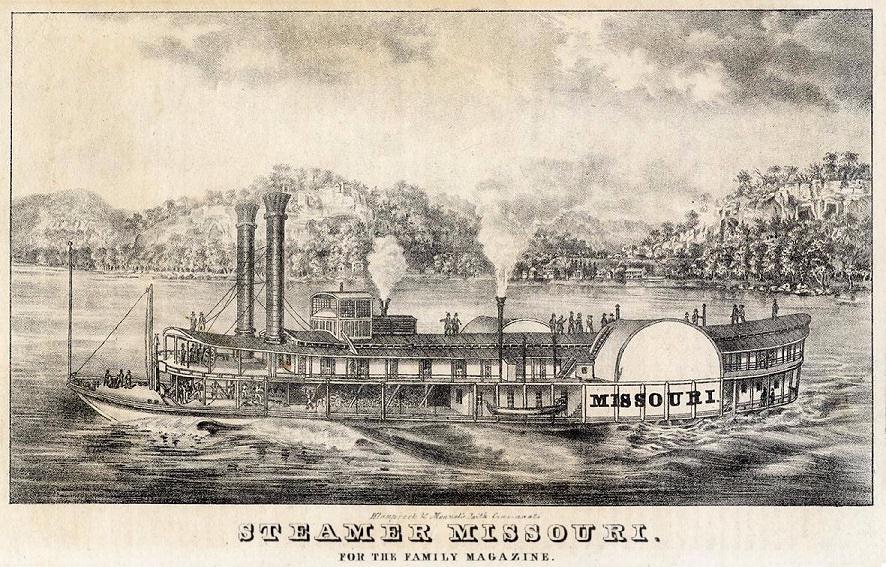
The MISSOURI was built in 1845, ran in the St. Louis-New Orleans trade and was lost in a fire at St. Louis on July 8, 1851.
This engraving appeared in an 1850 edition of The Family Magazine. The illustration was lithographed by Klaupreck & Menzel in Cincinnati, apparently based on art by John Caspar Wild.
The MISSOURI's nickname was "The Big Missouri" and she was the boat that the boy Ben Rogers was "personating" when he approached Tom Sawyer while he was whitewashing the fence in Chapter 2 of Mark Twain's 1876 novel ADVENTURES OF TOM SAWYER:
Ben Rogers hove in sight presently . . . Ben's gait was the hop-skip-and-jump - proof enough that his heart was light and his anticipations high.
He was eating an apple, and giving a long, melodious whoop, at intervals, followed by a deep-toned ding-dong-dong, ding-dong-dong, for he was personating a steamboat. As he drew near, he slackened speed, took the middle of the street, leaned far over to star-board and rounded to ponderously and with laborious pomp and circumstance - for he was personating the Big Missouri, and considered himself to be drawing nine feet of water. He was boat and captain and engine-bells combined, so he had to imagine himself standing on his own hurricane-deck giving the orders and executing them:
"Stop her, sir! Ting-a-ling-ling!" The headway ran almost out, and he drew up slowly toward the sidewalk.
"Ship up to back! Ting-a-ling-ling!" His arms straightened and stiffened down his sides.
"Set her back on the stabboard! Ting-a-ling-ling! Chow! ch-chow-wow! Chow!" His right hand, meantime, describing stately circles - for it was representing a forty-foot wheel.
"Let her go back on the labboard! Ting-a-ling-ling! Chow-ch-chow-chow!" The left hand began to describe circles.
"Stop the stabboard! Ting-a-ling-ling! Stop the labboard! Come ahead on the stabboard! Stop her! Let your outside turn over slow! Ting-a-ling-ling! Chow-ow-ow! Get out that head-line! Lively now! Come - out with your spring-line - what're you about there! Take a turn round that stump with the bight of it! Stand by that stage, now - let her go! Done with the engines, sir! Ting-a-ling-ling! Sh't! s'h't! sh't!" (trying the gauge-cocks).
Tom went on whitewashing - paid no attention to the steamboat.
Ben stared a moment and then said: "Hi- yi ! You're up a stump, ain't you!"
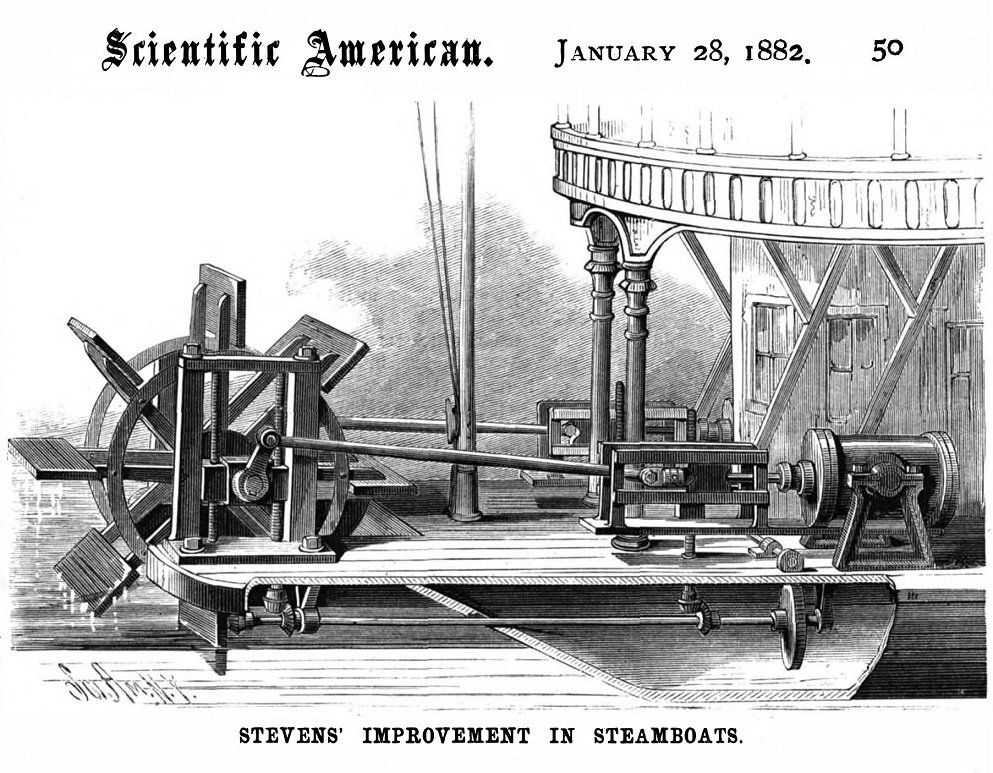
Attached engraved illustration from a January, 1882 SCIENTIFIC AMERICAN article about an innovation to enhance the performance of paddlewheels on steamboats that plied American rivers. Looks like a steampunker's phantasy.
It would be interesting to know how many, if any, paddlewheelers were customized to use this invention. I don't recall seeing any photographs in which such a device could be plainly seen on a sternwheeler. In the case of sidewheelers the devices would not be visible from outside the boat. The inventor Robert L. Stevens was a resident of Albany, Oregon on the Willamette River where steamboat commerce was thriving during the 1880's. A steamboat that navigated the Willamette River would have been the most likely candidate to have installed a prototype of this innovation in order to give it a trial run.
Page 50 SCIENTIFIC AMERICAN 28 January 1882
Text of the article:
IMPROVEMENT IN STEAMBOATS.
Every boatman knows that the angle and depth at which the wheels of steamers strike the water affect vary greatly their speed and power of propulsion, involving as a consequence the questions of time and consumption of fuel. The loading and unloading of a vessel alter the dip of the paddle; the heavier the load the greater the dip and angle, destroying the effective power of the engine. To remedy this difficulty many devices have been planned, the best of which are only partially effective, all more or less complicated, and the additional machinery being very liable to get out of order. The most common plan for side-wheel boats is the feathering wheel, which makes each paddle strike the water at right angles, but when deep in the water the power is applied at a great disadvantage, and too much of the wheel submerged for effective use.
A wheel large in proportion to the size of the boat and capacity is generally accepted as a solution of the difficulty; the vessel being constructed so that the load will not sink her below a line of effective working power. In sternwheel boats the load is mainly carried on the bow, so that they do not run on an even keel, and the resistance of the water through which they plow their way is greatly increased. Other craft of this kind raise and lower the wheels by several devices not applicable to large and powerful boats.
Mr. Robert L. Stevens, of Albany, Oregon, has recently Patented a device which raises and lowers the wheels of either side on sternwheel boats, so that whether the vessel be loaded or unloaded the paddle will strike at the most effective angle and depth, securing the greatest speed with a minimum of power, while the driving engines are not interfered with. This is effected by a series of screw shafts arranged for simultaneous movement by the driving engine, and they do not detract from the strength of the wheel or boat. The arrangement is not complicated, and adds but comparatively little to the weight.
The advantages of this improvement are many. The wheels and engines of large boats can be made smaller and driven faster, economizing weight and fuel, the destructive jar of an overloaded boat and its powerful engine obviated, increasing the durability of both. They can be deeply loaded without changing the paddles to a smaller diameter, as is often done on the Mississippi. They can be built deeper and longer, doubling or tripling their capacity in deep rivers. With light loads they can run up the shallow rivers at full speed, and thus avoid expensive transfers of freight, and their draught only limited by the depth of the rivers in which they ply. For example, a vessel drawing twelve feet of water when loaded with 1,000 tons, could start from New Orleans, leave portions of her freight at the great centers of commerce, and with a light load left, say 150 tons, and drawing three and a half feet or less, mount the swift and shallow tributaries of the Mississippi, carrying freight directly to its destination instead of transferring it to a steamer of lighter draught.
The paddle wheel and its shaft are supported at the stern of the vessel, as shown in the engraving, by boxes which are formed with side flanges entering grooves formed in fixed posts, so that the boxes are free to be raised and lowered. Screw shafts, supported at the top and bottom, pass through the internally threaded flanges of the boxes, so that the boxes with the wheel and shaft are sustained by the screws. On the lower ends of the screws, at each side, there are bevel gear-wheels meshing with similar gears on shafts that are fitted longitudinally of the vessel at each side.
The cylinders are hung for oscillation on trunnions, and the slides are connected to the cylinders so as to retain their proper relative position. A screw is fitted in connection with a. nut on each. slide. for swinging the slide and cylinder and sustaining them. All of the screws are connected for simultaneous operation. The movement being in an arc from the trunnions, the screws and bevel gearing are proportioned to obtain the variation in movement. To allow vertical movement of the boxes the piston and eccentric rods are fitted with right and left hand screw turn buckles, so that the rods can be lengthened and shortened. The invention can be applied in connection with side paddlewheels and beam engines by changing the relative position of the parts.
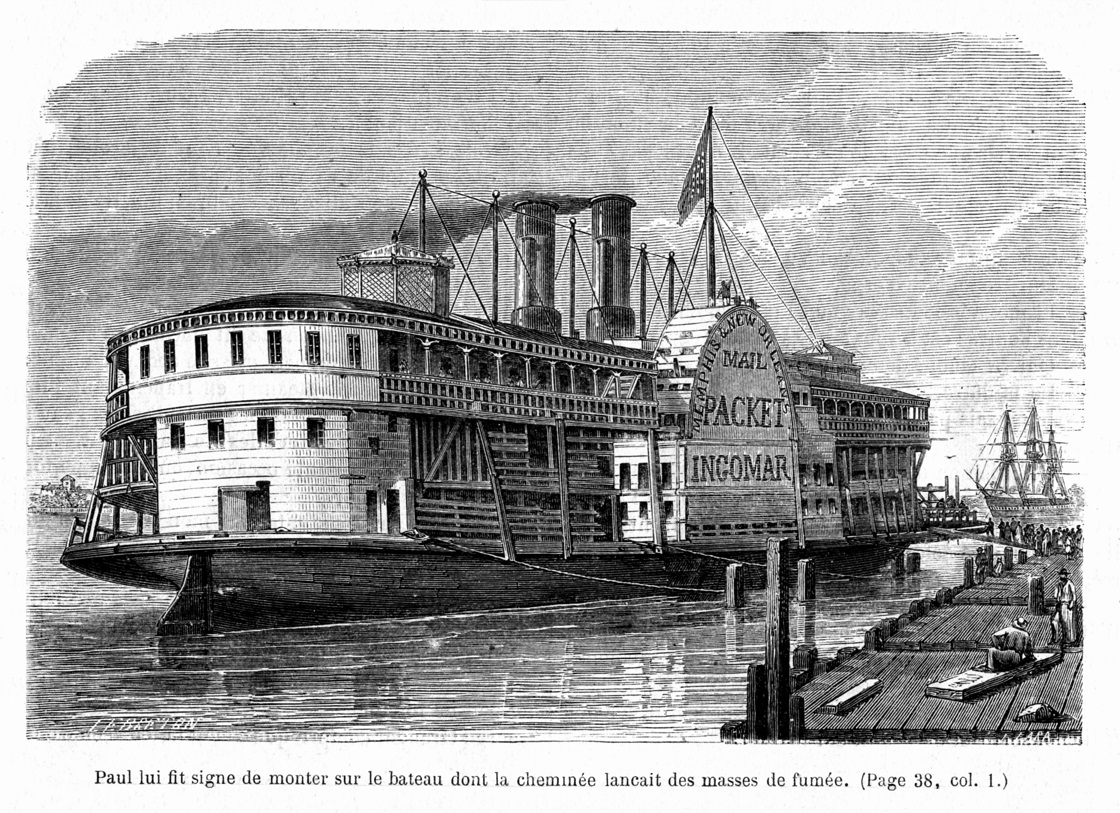
An unusual engraving from an unknown French publication of the steamboat INGOMAR, probably dating from between 1854 and 1862 when the boat was in service. The engraver based this on a drawing by Louis LeBreton who traveled the world in sailing ships as a French Naval surgeon and artist. (A summary of his career can be found below). The details of the stern and starboard of the boat are consistent with steamboats as we know them, but the stacks are considerably larger in diameter than the ones on boats that plied the rivers at that time, the stacks in the engraving look like they belong on an ocean-going vessel. The squat structure with a peaked room at the far end of the hurricane roof may represent the pilot house but it is only a fraction of the size of the ones on riverboats that we are familiar with. The engraver may have misinterpreted LeBreton's drawing and consequently improvised much of what would have been on the hurricane roof of the actual INGOMAR.
Here is an approximate translation of the French caption under the engraving:
"Paul recognized that it was time to board the boat when the smokestacks began to produce clouds of black smoke."
INGOMAR
Sidewheel packet boat
Way's Packet Directory Number 2759
Built for the Memphis & New Orleans Packet Co. at Louisville, Kentucky in 1854.
730 tons. 275 x 40 x 7.5. Engines, 28's- 7 ft.
In 1855, Capt. L. McDonough was in command with H.R. McLauglin, clerk;
in 1857-1858 Capt. Burdett Paras was in command.
In 1860-1861, Capt. Joe D. Clarke was in command.
Capt. Clarke joined up with the Confederates in 1861 and survived the Civil War unscathed when it ended in 1865.
The INGOMAR was dismantled at New Orleans 1862 and her engines went to the Confederate gunboat LOUISIANA.
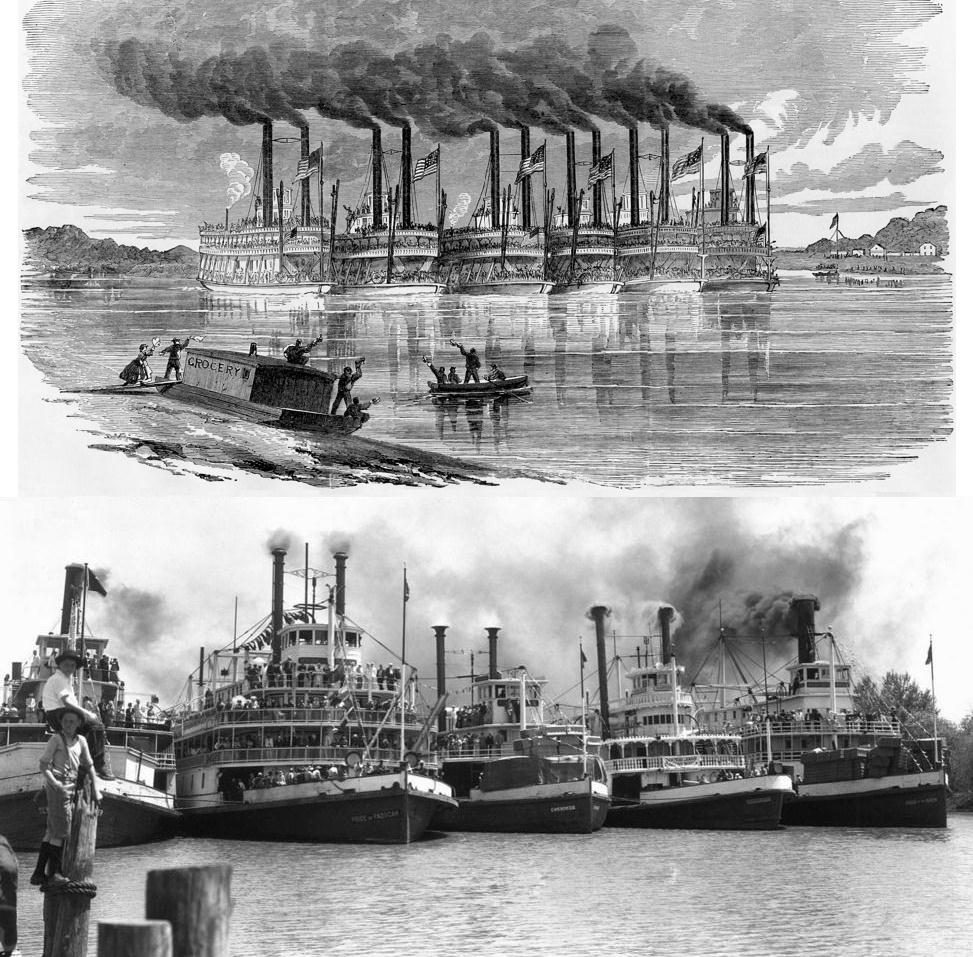
The Civil War scene drawn by artist Frank Schell (top) of a half dozen steamboats carrying General Negley's Pennsylvania Brigade among others down the Ohio River in October 1861. It's reminiscent of the line up of the 5 racers for STEAMBOAT ROUND THE BEND. It is possible that the engraved image published in Frank Leslie's Illustrated Newspaper for November/December1861 (center) inspired the way the Sacramento River steamers were positioned "cheek by jowl" at the start of the climactic race in the movie (bottom).
The Sacramento boats are in some ways more interesting because they are quite different in appearance from each other in size and configuration while the Ohio River "fleet" boats all look pretty much the same.
(Detail from):
"Passage down the Ohio River of General James S. Negley's Pennsylvania Brigade, the Seventy-Seventh, Seventy-Eighth and Seventy-Ninth Regiments. Pennsylvania volunteers under Colonels Hambgright, Stambauch and Sewall"
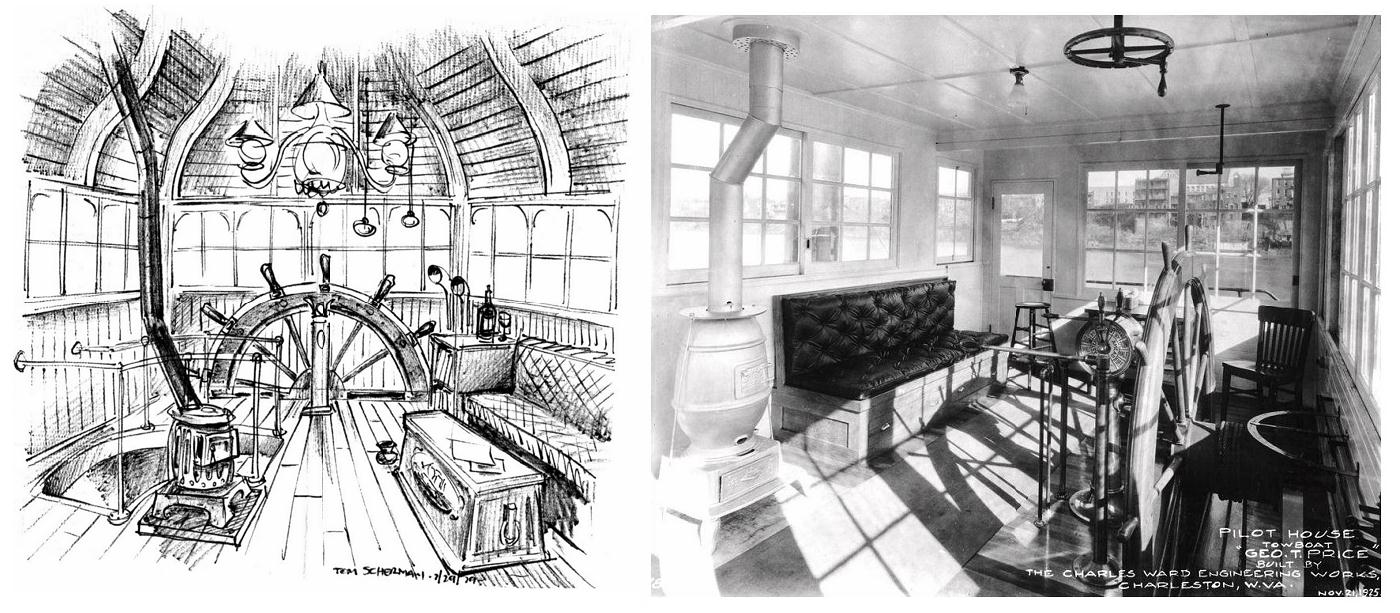
My friend Tom Scherman (1940-1995) is celebrated for his brilliant models of the "futuristic Victorian" submarine NAUTILUS designed by art director Harper Goff of Disney's 1954 film adaptation of Jules Verne's prophetic 1870 novel 20,000 LEAGUES UNDER THE SEA.
tomscherman.blogspot.com
vulcaniasubmarine.com
Tom converted the interior of one of his Hollywood apartments into Captain Nemo's chart room, complete with a "hatch" behind the front door where you entered and saw four walls and ceiling were all rusty and riveted bulkheads and the tentacle of a giant squid snaked along the ceiling, having intruded out of a hatch at the top of a steep and narrow staircase at the south end of the room. A big chart of the ocean where Nemo's secret lair "Vulcania" was on the north wall.
Ray Bradbury was so impressed with Tom and his apartment that he immortalized him as "Tom Shipway" in the novel A GRAVEYARD FOR LUNATICS where the character appears in Chapters 28 and 29.
Bradbury also commissioned Tom to build him a model of Harper Goff's NAUTILUS which was seen in Ray's "office" at the beginning of each episode of THE RAY BRADBURY THEATER from 1985 to 1992.
Tom habitually sketched on napkins when he dined out and in 1979 he began making a series of concept drawings for a pilot house that he encouraged me to build for myself as a "den."
Attached is my favorite of the pilot house sketches Tom made and next to it a 1925 photo of the pilot house of the Towboat GEORGE T. PRICE which I first saw a few years ago and know Tom never saw.
Even Tom would have been amazed at the uncanny coincidences in the details of the crooked stove pipe and the upholstered "lazy bench" which they both have in common.
I don't believe if Tom ever saw any photos of the GOLDEN EAGLE's pilot house either but here in his sketch is the same interior detailing of arches overhead holding up the GOLDEN EAGLE's distinctive roof.
I will never forget the day Tom and I walked the length of the L.A. Harbor breakwater out to the lighthouse and back.
Along the way Tom told me the plot and dramatic highlights of Victor Hugo's 1866 maritime novel TOILERS OF THE SEA.
On his way back from a family gathering in Cape Cod in the early 1980's Tom met me in Hannibal, MO where I was vacationing and he thoroughly impressed my friends Ruth and Charles Anton and Hurley and Roberta Hagood.
Tom built scale models of every description from the Jim Hawkins' Admiral Benbow Inn from Stevenson's TREASURE ISLAND to a castle inspired by the Griffith Observatory that was exploded at the end of a bawdy film satire of FLASH GORDON in 1972. Of course anything maritime captured Tom's imagination and he built models of many varieties of boats and ships as well as "flying machines" in the tradition of Jules Verne.
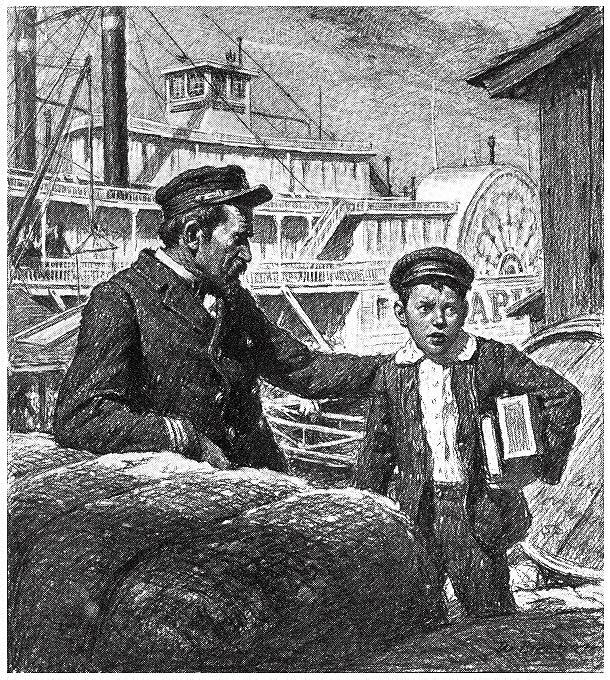
Irvin S. Cobb was the humorist from Paducah, Kentucky who played "Cap'n Eli" in STEAMBOAT ROUND THE BEND opposite Will Rogers.
Cobb's 1924 novel (quoted below) was his "Tom Sawyer" story based on his boyhood years in Paducah on the Ohio River when he was 13 "goin' on 14."
When the boy hero runs away from home he talks to Cap'n Mike Goddard of the steamboat RAPIDAN about joining the crew so he can escape his hometown that way.
Goddard proceeds to offer the boy a berth on the boat but frightens him by exaggerating the privations and difficulties of being low man on the totem pole.
The boy does not return to the boat when it leaves but instead watches wistfully from shore as she departs.
The attached illustration from the book is by Worth Brehm who also illustrated later editions of Mark Twain's TOM SAWYER and HUCKLEBERRY FINN for Harper & Bros.
Goin' on Fourteen
by Irvin S. Cobb
George H. Doran Co.
1924
Closing paragraphs from Chapters 18:
"At eleven o'clock the RAPIDAN sent a roaring signal up the wharf and the clamor of it scattered the pigeons feeding on scattered grain upon the graveled incline.
It roused five or six persons of the leisure class, one of them plain, the rest colored, who had been drowsing in sunny spots behind bales and hogsheads awaiting shipment, and it brought tardy travelers hurrying down the slope.
At eleven-ten, to an accompaniment of starting bells jangling in the engine room and the scrape of gangplanks being drawn in, she whistled once again in final warning.
From a hastily tunneled retreat well back in the sawdust pile of Langstock's mill a quarter of a mile away, the refugee did not stir.
He had been there for quite a while; he would continue patiently to lie there until all peril had passed.
Better be slow and safe than to be precipitate and sorry.
He waited until the diminishing bucketty-bucketty of paddle-wheels and the sighing, tired-sounding exhalations of her 'scrape pipes told him the packet had swung out into the current and was really off, beyond possibility of recall, on her winding course through the lower bends.
Even so, his manner of emerging from his fastness showed caution.
He sat on a saw-log in the shelter of the planing shed to dig itchy particles out of his neck-band and his ears and take stock of matters in general.
One thing was sure: the glamorous aspect of steamboating had been exposed for a false and misleading thing."

With the exception of images credited to public institutions,
everything on this page is from a private collection.
Please contact Steamboats.com for permission for commercial use.*
All captions provided by Dave Thomson, Steamboats.com primary contributor and historian.
